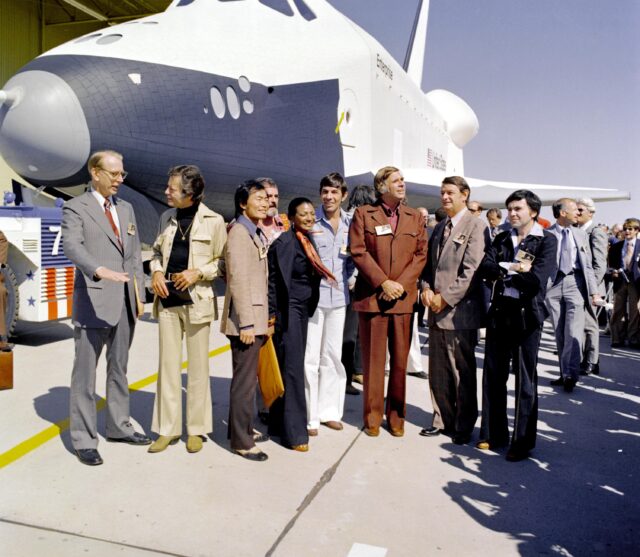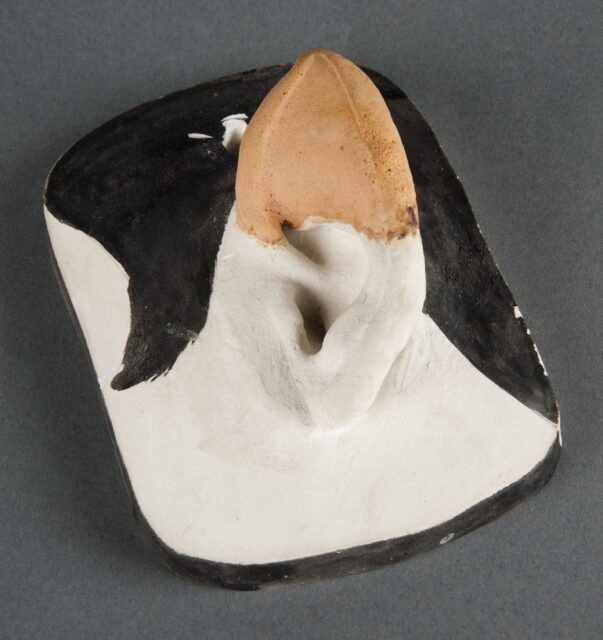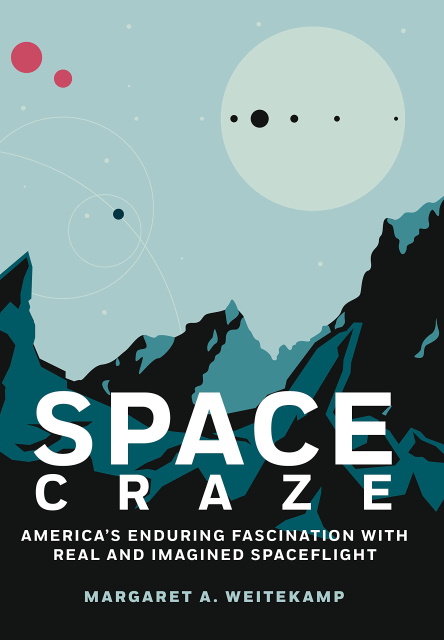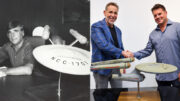A new book from Smithsonian Publishing about the history of space flight investigates how spaceflight, both real and imagined, has served as the nexus where contemporary American concerns, such as race, gender, sexuality, freedom, and national identity have been explored and redefined. Star Trek fandom plays a large role on the book, and we have an excerpt and photos to whet your appetite. The book is out this week.
Space Craze: America’s Enduring Fascination with Real and Imagined Spaceflight
Described as “A space historian’s tour through astounding spaceflight history and the Smithsonian’s collection of space and science fiction memorabilia,” the book by Margaret A. Weitekamp covers historical milestones in space exploration, films and TV shows, literature and comic strips, toys and games, and internet communities.
One of the chapters that covers Star Trek digs into the history of Trek fandom (which is referred to as a “cultural force”) and its effects on culture as the general public’s interest in space exploration.
Here is an extended excerpt:
STAR TREK LIVES!
The persistence of Americans’ excitement about spaceflight throughout the twentieth century hinged on its malleability. Just as Buck Rogers solidified the basic form and archetype of American science fiction in the late 1920s and 1930s, Star Trek offered a fresh take on that formula in the 1960s. Even with some new variations, however, the space adventure’s cultural roots in the Western remained clear. As one influential fan summed up the program’s core appeal: “Star Trek was very good ‘space opera’ (a starship instead of a horse, phasers instead of six-shooters, and a walk-down on Tau Ceti instead of the O. K. Corral, etc.).” Gene Roddenberry’s vision of humanity exploring the stars, coupled with the Vulcan philosophy of IDIC (Infinite Diversity in Infinite Combinations)—a radical expression of equality—gave Star Trek an optimistic bent. The show did not suggest that all problems had been solved, but it depicted a potential future without scarcity in which people worked to build a better society. In the early 1970s, the program’s fans went to great lengths to connect with others who shared their passion.
The public response expressed by Star Trek’s supporters never reached the level of widespread excitement seen after John Glenn’s orbital flight in 1962. But Star Trek’s devotees created an ardent niche fandom. Although not broad, it was deep and, from early on, organized. As its coordinators (often women) forged links with newsletters, fanzines, and mailing lists, far-flung pockets of enthusiasts became a national force. Star Trek became a greater force after it was canceled than it had been when it first aired.
Star Trek’s fan base took form during the show’s initial run and persisted even after the end of the third broadcast season. Reflecting on those years, an early fan newsletter summarized the fledgling movement, “For three years after Star Trek’s demise, Star Trek’s fandom has grown. Individual pockets of fans across the world thought they were the only ones left.” Despite that perception of isolation, the makings of an esoteric and eccentric network existed. As the same publication reflected, with some affection, the show’s followers were “a vast, complicated, highly interesting, volatile group of people.” The growing community built its links through in-person gatherings and by circulating newsletters and other homegrown publications. In the 1970s, the membership of fan clubs remained necessarily local, geographically limited by the reasonable distances that people could travel to attend. Newsletters reached farther. Enthusiastic followers also started various Star Trek fan-based magazines, called “zines,” with hand-drawn illustrations and other informal touches, in which they could share their excitement with like-minded supporters during the show’s initial run and afterward. These typewritten missives compiled updates, news, poetry, and illustrations, along with, in some cases, original fan-authored fiction.
Given the technology available, producing and distributing newsletters and fanzines required a lot of work. Initially, editors and authors arranged columns using a typewriter, and then copied the layouts using mimeographs or ditto machines to produce small batches for distribution. By the early 1970s, however, instant offset printshops made better-quality reproductions affordable enough for some hobbyists. Reduction printers fit more text onto fewer pages, which reduced mailing costs. The final sheets still had to be stuffed into envelopes or stapled into packets, however, before being labeled and stamped to deliver via mail. Distribution did not necessarily end there. Recipients might keep their copies—or pass them along to fellow fans. Even given the demands of creating them, it is estimated that more than a hundred fanzines existed by 1972.
In January of that year, the first Star Trek fan convention assembled at the Statler Hilton Hotel in New York City. This “con” was the first one convened in the format that later came to characterize such gatherings, especially with stars as featured guests. Elise Pines and Joan Winston organized the gathering with the intention of sharing their love of Star Trek with two hundred or so fellow fans. But before the meeting even began that Friday, at least that many people were already lined up outside, waiting for hours to be the first in the door. By Sunday, three thousand people had purchased tickets. The organizers eventually stopped charging admission because they could not keep up. Once inside, attendees mixed and mingled, watched a special showing of “The Cage,” and viewed a Star Trek blooper reel. Show creator Gene Roddenberry and noted novelist Isaac Asimov appeared, speaking to fans and answering questions. The official Star Trek fan club also enrolled its first members at that gathering, creating a sanctioned national organization in addition to the myriad local groups that already existed.
In January 1972 as well, George Christman founded the first chapter of the Star Trek Association for Revival (STAR) in Ann Arbor, Michigan. It sought to bring Star Trek back to television using the same kind of mailing campaign that had helped secure the program’s third season. The first issue of the group’s newsletter, Star Borne, included instructions for writing to NBC and Paramount using personal appeals, not petitions or form letters, for maximum effect. As it had before, the campaign worked. Star Trek went into syndication later in 1972. According to Thomas, that corporate decision “can be attributed solely to the efforts of the show’s fans.” In reruns, the entertaining program found new audiences, creating a second generation of viewers. Within a few years, as new fans joined those who had watched in first run, disparate viewers coalesced into a fledging community.
A group of volunteers called the Star Trek Welcommittee provided key logistical support for the growing fan base. As founder Jacqueline Lichtenberg explained in 2015, “Today, people don’t understand that ‘fandom’ was a web of social networks of organizations with constitutions, dues, bylaws, and internal publications, organizations of adults.” Lichtenberg got the idea for an orientation committee from a similar group operated by the National Fantasy Fan Federation, a correspondence club for science fiction and fantasy aficionados that began in 1941. Founded in the summer of 1972 and initially chaired by Jeanne Haueisen, the Welcommittee served as a “central information center to answer fans’ questions about Star Trek, and provide new fans with complete information about Star Trek and Star Trek fandom.” The Welcommittee was not a club itself but an organized network of volunteers who supported clubs and other fans. It was a substantial effort. By December 1973, the service organization included one hundred volunteers working in twenty-three states.
The exuberance of the group’s tagline—“Star Trek Lives!”—highlighted the grassroots movement’s determination to remain optimistic in cynical times. To sustain that energy, fans sought connections. In the early 1970s, supporters interested in collecting Star Trek–related memorabilia had limited options. They could obtain scripts or film clippings from Gene Roddenberry’s mail-order company, Lincoln Enterprises, or they could seek out specialty sellers through mail-order catalogs or in-person displays at conventions. The Welcommittee’s directories listed relevant books, upcoming meetings, and the contact information for various merchandise purveyors. Just as important, however, the Wel- committee maintained long lists of active clubs and zines. The tightly spaced entries included mailing addresses, along with details about required dues and other requirements for joining. The “Star Trek Directory” published in October 1973, for instance, listed a hundred and eleven active clubs, including thirty-eight different chapters of STAR. In the same issue, fans could learn how to obtain copies of eighty-eight different active zines through the mail. Recognizing that fan efforts also disbanded regularly, the same directory listed twenty-seven out-of-print zines and twenty-four defunct clubs.
The economy of Star Trek fandom ran on volunteers’ time and myriad small donations. Many of the entries in the typed directories included specific information about required dues or requested contributions. Payments as small as a quarter or fifty cents could be sent by check or money order to offset expenses. Fees could also be paid by enclosing the equivalent monetary value in uncanceled US postage stamps. Although many newsletters and zines relied on bulk mailing rates to keep costs down, sending first-class stamps defrayed correspondence costs. Indeed, good fan etiquette called for writers to include a self-addressed stamped envelope (SASE) with any requests or inquiries to avoid burdening the volunteer providing the reply.
In addition to participating in a local fan group or reading newsletters and zines, attending conventions became a signature part of the Star Trek fan experience. Like the New York convention, these get-togethers built on the traditions established by literary science fiction or comic book conventions. Many were regionally focused and fan-organized. For instance, Bjo and John Trimble, who led the “Save Star Trek” campaign in the late 1960s, organized Equicon (named for its timing near the vernal equinox) as a West Coast Star Trek convention in Los Angeles in 1973 and 1974. The atmosphere at conventions—whether organized around general science fiction or Star Trek specifically—tended to be friendly. Families were welcomed, and Equicon offered babysitting. In that convivial environment, Star Trek fans also created new traditions. For example, participants who wanted to show off their costumes outside of the scheduled parades began the practice of wearing them on the convention floor throughout the meeting. Even as costumed convention-goers began to feed outsiders’ stereotypes about the unbridled enthusiasm of diehard fans, NASA recognized the group as a receptive audience. The space agency sent representatives and displayed a lunar lander model at the very first Star Trek convention in New York City.
Some fan organizations also recognized the overlapping interests of real and imagined spaceflight. One of the first issues of Menagerie, a zine that published some of the first Star Trek fan fiction, included advertisements for both Klingon Empire appointment calendars and 8 × 10 Apollo 11 photographs. Fans who might have ordered either (or both) probably did not live near many others who shared their tastes. Thanks to the hard work of volunteer organizers, however, a fledgling network of clubs and mailings connected them with other fans.
Smithsonian photos
There are also a few photos from the Smithsonian’s collection, like this one of a foam rubber replica prop of a Star Trek Vulcan ear tip. It was donated to the Smithsonian National Air and Space Museum by Douglas Drexler, Ron Barlow, and Anthony Frederickson. According to the book, their visit and the donation grew from a surge in fan enthusiasm in the 1970s for the canceled television program.
They include this classic photo of most of the Star Trek: The Original Series at the rollout of the space shuttle orbiter Enterprise, taken on September 17, 1976.

(Left to right) NASA Administrator James D. Fletcher greets luminaries from television’s Star Trek (1966–69), including DeForest Kelley, George Takei, James Doohan, Nichelle Nichols, Leonard Nimoy, Gene Rodenberry, US Rep. Don Fuqua (D-FL), and Walter Koenig at the rollout of the space shuttle orbiter Enterprise in Palmdale, California. Photo courtesy of the National Air and Space Museum, NASM NASA-76-HC-765
Out today
Space Craze: America’s Enduring Fascination with Real and Imagined Spaceflight from Smithsonian Books was released today, Tuesday, October 18. The 304-page book is available via Amazon in Hardcover for $29.95 and Kindle ebook for $23.02.
Find more news and reviews of Star Trek books at TrekMovie.com.
DISCLAIMER: We may link to products to buy on Amazon in our articles; these are customized affiliate links that support TrekMovie by earning a small commission when you purchase through them.








Very cool expert. I’m always and amazed and incredibly impressed with how fandom not only existed, by thrived and grew pre-interwebs. Even in the late 80s you had BBS systems you could dial into, but the in the 70s it really was just stamps and letters. Phenomenal.